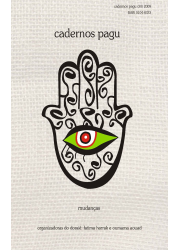Resumo
Este artigo analisa narrativas árabe-islâmicas que tratam de noções de corporalidade e suas conexões com a prática da circuncisão feminina, mostrando que a relação existente entre circuncisão, sexualidade e poder está posta em um cenário que envolve não apenas um idioma religioso de conversão de quem está dentro (crente) e fora (descrente) e em estados de “poluição”, assim como a conversão simbólica entre masculino/feminino subjacente à construção da “comunidade muçulmana” ou califado.
Abstract
This article analises Arab-Muslim narratives dealing with concepts of embodiment in the practice of female circumcision, pointing out that the conection among circumcision, sexuality and power takes place in a setting which involves a religious language of conversion among insiders (believers), outsiders (non-believers) and those in state of “pollution” as well as the simbolic conversion between male/female identities subjacent to the idea of “Islamic community” or caliphate.
Key Words: Arab-Muslim Literature, Allegories of Gender and Embodiment, Female Circumcision, Islamic Historiography
Referências
ABU-SAHLIEH, Sami. Male & Female Circumcision Among Jews, Christians and Muslims – religious, medical, social and legal debate.
Pennsylvania, Shangrila Publications, 2001.
AL-SAADAWI, Nawal. The Hidden Face of Eve – Women in the Arab World. London, Zed Books, 1991.
ARMSTRONG, Karen. Maomé – Uma biografia do Profeta. São Paulo, Companhia das Letras, 2002.
BARTHES, Roland. Fragmentos de um discurso amoroso. São Paulo, Martins Fontes, 2003.
BAUDRILLARD, Jean. Da Sedução. Campinas, Papirus, 2006.
BEACH, Eleanor Ferris. The Jezebel Letters – religion and politics in ninth-century Israel. Minneanapolis, Fortress Press, 2005.
BEGG, Ean. The influence of the East. In: The Cult of the Black Virgin.
London, Penguin Books, 1996.
BODDY, Janice. Wombs and Alien Spirits – women, men and the Zar cult in Northern Sudan. Madison, University of Wisconsin Press, 1989.
BUTLER, Judith. Fundamentos contingentes: o feminismo e a questão do pós-modernismo. Cadernos Pagu (11), Campinas-SP, Núcleo de Estudos de Gênero - Pagu/Unicamp, 1998, pp.11-42.
DOUGLAS, Mary. Introdução e Fronteiras exteriores. In: Pureza e Perigo – Ensaio sobre as noções de poluição e tabu. Lisboa, Edições 70, 1976.
EICKELMAN, Dale F. Mass higher education and the religious imagination in contemporary Arab societies. In: The Book in The Islamic World – The written word and communication in the Middle East. New York, The Library of Congress, 1995.
GOEL, Sita Ram. Islamic theology of iconoclasm. In: Hindu Temples: what happened to them – the Islamic evidence, volume II. New Delhi, Voice of India, 1993.
_________. Was the Ka’ba a Siva Temple? In: Hindu Temples: what happened to them – the Islamic evidence, volume II. New Delhi, Voice of India, 1993.
GOMES, Purificacion Barcia. Sheerazade feminista? In: O método terapêutico de Sheerazade: Mil e uma histórias de loucura, desejo e cura. São Paulo, Iluminuras, 2000.
HOURANI, Albert. O pensamento árabe na era liberal – 1798 – 1839. São Paulo, Companhia das Letras, 2005.
JAROUCHE, Mamede Mustafá. Livro das Mil e Uma Noites – ramo sírio – volume I. São Paulo, Globo, 2005.
KENNEDY, John G. Circumcision and excision in Egyptian Nubia. Man – The journal of the Royal Anthropological Institute, 5(2), 1970.
LASSNER, Jacob. Demonizing the Queen of Sheba – Boundaries of gender and culture in postbiblical Judaism and medieval Islam.
Chicago, The University of Chicago Press, 2002.
LÉVI-STRAUSS, C. A eficácia simbólica. In: Antropologia Estrutural I. Rio de Janeiro, Tempo Brasileiro, 1996.
MCCLINTOCK, Anne. Imperial Leather – Race, Gender and Sexuality in the Colonial Context. NY/London, Routledge, 1995.
MERNISSI, Fátima. The Forgotten Queens of Islam. Minneapolis, University of Minnesota Press, 2003.
__________. Sonhos de transgressão – minha vida de menina num harém. São Paulo, Companhia das Letras, 1996.
NAFISI, Azar. Imagination as subversion: narrative as a tool of civic awareness. In: Muslim Women and the Politics of Participation.
Syracuse/NY, Syracuse University Press, 2002.
OAK, P.N. Was the Kaaba originally a Hindu Temple? 2004.
www.hindunet.com/forum/ ROGERSON, Barnaby. O Profeta Maomé – uma biografia. Rio de Janeiro, Record, 2004.
ROUHANA, Hoda. Crimes de honra – perspectiva de mulheres que vivem sob lei muçulmana. In: CORRÊA, Mariza e SOUZA, Érica Renata de.
Vida em Família – uma perspectiva comparativa sobre “crimes de honra. Campinas-SP, Núcleo de Estudos de Gênero - Pagu/Unicamp, 2006.
SHOHAT, Ella. Des-orientar Cleópatra: um tropo moderno de identidade.
Cadernos Pagu (23), Campinas-SP, Núcleo de Estudos de Gênero - Pagu/Unicamp, 2004, pp.11-54.
SICUTERI, Roberto. Lilith – A Lua Negra. São Paulo, Paz e Terra, 1998.
UD-DIN ATTAR, Farid. A Linguagem dos Pássaros, São Paulo, Attar Editorial, 1991.
The Noble Qur’an – English Translation of the meanings and Commentary. Madinah, King Fahd Complex For the Printing of the Holy Qur’an, 2005.

